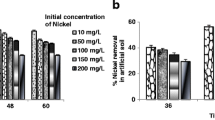Abstract
An alternative to the cleaning-up of agricultural soil contaminated by heavy metals is to avoid their transfer from soil to plant by inoculating soil with selected microorganisms able to biosorb heavy metals. Here, four bacteria species and a fungus isolated from contaminated soils revealed their ability to grow in the presence of high cadmium level. We tested their growth capacity related to pH and Cd concentration on synthetic and soil extract media. The comparison of their growth rate, the biosorbed cadmium rate and the specific biosorption allowed to select the most efficient microorganism to be used in bioremediation.



Similar content being viewed by others
References
Amoroso MJ, Castro GR, Carlino FJ, Romero NC, Hill RT, Oliver G (1998) Screening of heavy metal-tolerant actinomycetes isolated from the Sali River. J Gen Appl Microbiol 44:129–132
Bagot D, Lebeau T, Jezequel K, Fabre B (2005) Selection of microorganisms for bioremediation of agricultural soils contaminated by cadmium. In: Lichtfouse E, Schwarzbauer J, Robert D (eds) Environmental chemistry. Springer, pp 215–222
Bailey SE, Olin TJ, Bricka RM, Adrian DD (1999) A review of potentially low-cost sorbents for heavy metals. Water Res 33:2469–2479
Boularbah A, Morel JL, Bitton G, Guckert A (1992) Cadmium biosorption and toxicity to six cadmium-resistant Gram-positive bacteria isolated from soil. Environ Toxicol Water Qual: An Int J 7:237–246
Bourrié B, Tourlière PY, Bernhard-Bitaud C (1998) Uptake of cadmium, lead, copper and zinc by maize crop: results of a four-year field experiment. In: Proceedings of the 16th World Congress of Soil Science, 20–26 August 1998, Montpellier, France
Chang J-S, Law R, Chang C-C (1997) Biosorption of lead, copper and cadmium by biomass of Pseudomonas aeruginosa PU 21. Water Res 31,7:1651–1658.
Gabriel J, Vosahlo J, Baldrian P (1996) Biosorption of cadmium to mycelial pellets of wood-rotting fungi. Biotechnol Lett 10:345–348
Jacoby GA (1986) Resistance plasmids in Pseudomonas aeruginosa. In: Gunsalus IC, Sokatch JR, Ornston LN (eds) The bacteria, vol X, chapter17. Academic Press, Orlando, FL, pp 497–514
Valentine NB, Bolton H, Kingsley MT, Drake GR, Balkwill DL, Plymale AE (1996) Biosorption of cadmium, cobalt, nickel, and strontium by a Bacillus simplex strain isolated from the vadose zone. J Ind Microbiol 16:189–196
Acknowledgements
We are grateful to Dr. Amoroso, Dr. Gabriel and Dr. Valentine for providing us with the strains of Actinomyces R25 and R27, F. pinicola CCBAS 535 and the Bacillus ZAN-044, respectively.
Author information
Authors and Affiliations
Corresponding author
Rights and permissions
About this article
Cite this article
Bagot, D., Lebeau, T. & Jezequel, K. Microorganisms for remediation of cadmium-contaminated soils. Environ Chem Lett 4, 207–211 (2006). https://doi.org/10.1007/s10311-006-0047-0
Received:
Accepted:
Published:
Issue Date:
DOI: https://doi.org/10.1007/s10311-006-0047-0




